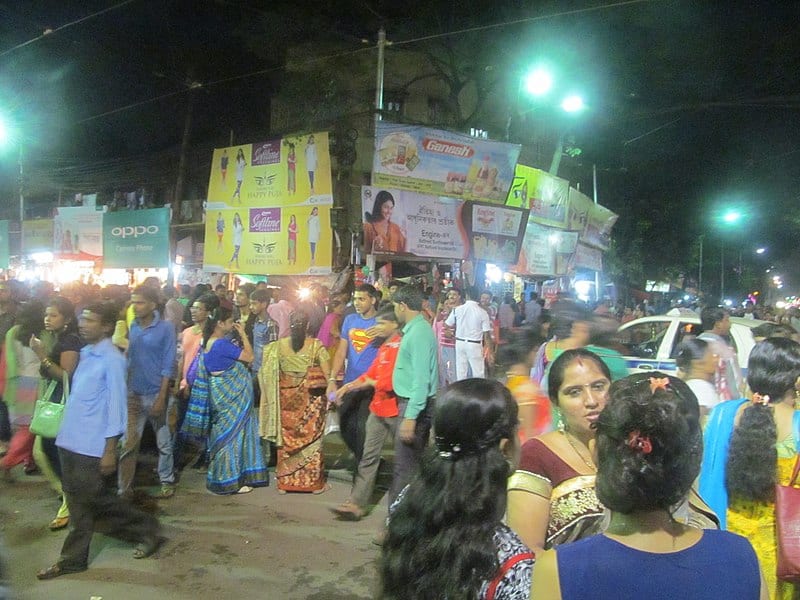In roughly a week from now, the city of Kolkata will be transformed into a spectacular carnival, a moving stream of countless heads, as tens of thousands descend on its roads to celebrate Durga Puja. In the capital Kolkata, this marks a magical celebration of not only the homecoming of Goddess Durga and her four children – Lakshmi, Saraswati, Kartik and Ganesh — but of art, creativity and life itself.
During the festival spanning five-days, Kolkata is decked up like a bride. ‘Pandals’, which look more like film sets these days, pop up across the city, where devotees will seek the blessings of ‘Maa’. While some community pujas have a budget running into crores, some are modest community celebrations. Alongside these are pujas organised by housing societies and of course, the heritage pujas in some of the traditionally affluent households of the aristocracy of yore.
By rough estimates, there are currently about 2652 Durga Pujas in Kolkata; yet, in this age of much-needed environmental consciousness, can the city afford to give itself up to celebrations with such mindless abandon?
Clean, green festival: An impossibility?
As this cultural extravaganza commences, the amount of waste generated shoots up, posing a huge challenge for the local administration. According to the Kolkata Municipal Corporation (KMC), the city generates an average of 4000 metric tons of waste on a regular day, which doubles during the Durga Puja celebration.
The problem has intensified in the last few-years with celebrations starting much ahead of Sasthi, as had been the tradition earlier. Political leaders and celebrities now inaugurate big ticket pujas as early as Mahalaya, adding to the duration of the festivities.
During the Durga Puja days, KMC, along with various other governmental departments, reportedly works round the clock to collect waste and take measures to curb pollution. But a lot more needs to be done.
“No matter how hard we work to keep the city clean, citizens have to come forward and cooperate. We have been undertaking plastic free drives and have requested all Durga Puja organisers to make celebrations plastic free, but not everyone has woken-up to the threat,” said Debashish Kumar, Member, Mayor-in-Council, “Currently, waste is collected in the usual way during the festival, but with more frequent collection from garbage vats and sweeping of roads. It’s good but not good enough.”
Strict immersion guidelines have been put in place and the immersion spots are barricaded and cleared after immersion, to keep the river clean.
According to Subrata Gupta, Principal Secretary, Urban Development and Municipal Affairs Department of the state government, by 2020 the state machinery will be more evolved and better equipped to tackle the huge quantity of waste generated during Durga Puja.
“At the next Durga Puja, we will arrange for segregated waste collection and we hope to have Material Recycling Facilities (MRF) in place all over the city. We are also working with the state Pollution Control Board and have installed automatic air quality monitoring and display systems in four points in Kolkata. Durga Puja revellers will be able to see real time pollution levels in the city,” said Gupta.
Wake-up call for citizens
The biggest challenge, according to Gupta, is sensitising people about the consequences of littering, the threats posed by single use plastic and the general increase in carbon footprint during festivities.
“This Durga Puja, we have come up with a booklet to make people aware about their responsibilities related to solid waste management during festivities, we have come up with a booklet on the topic. It will be distributed for free among revellers at the popular pandals during Durga Puja and will also be available on our website. Creating awareness among citizens is the most important weapon. Durga Puja is a good time to start as we can reach a huge number of people,” Gupta said.
The West Bengal Pollution Control Board (WBPCB) meanwhile claims to be taking steps to curb pollution during this Durga Puja. “In order to encourage the Durga Puja organisers of Kolkata to go green we have announced a Green Puja Award for the most eco friendly pujas in the city. In addition, on September 27th, we will be launching an app named ‘Poribesh’. The aim of this app will be to make people aware of pollution levels and educate them,” said Kalyan Rudra, Chairman of WBPCB. The app will also empower citizens to lodge complaints against violators of green norms.
The onus on Puja Committees
Some puja committees have, in fact, made an attempt to go green. Tridhara Sammilani, one of the big-ticket Durga Pujas in South Kolkata, claims to have shunned plastic. “The entire arena of our Puja is a plastic free zone. We take this very seriously. Apart from working with KMC for waste management, we also take extra care to ensure that our festival does not flout any green norms,” said Debashish Kumar, who is also one of the key organisers of Tridhara Sammilani’s puja.
The Durga Puja at Maddox Square is one of the biggest crowd-pullers in South Kolkata. “At any given point of time in the evenings, we have about 50,000 people at our Durga Puja ground, many spend hours at the sprawling grounds here. Littering of newspapers used by the crowd to sit on the fields is the biggest menace we have to tackle,” said Animesh Chattopadhyay, joint treasurer of Maddox Square Durga Puja, “This year we will be making announcements over the public address system so that people carry them back instead of dumping them here.”

This is how the grounds at Maddox Square look like after night long revelry by pandal hoppers. Pic: Biswarup Ganguly/Wikimedia Commons
Newspapers, however, are a lesser evil. As at other times, during puja celebrations too, single use plastic poses the greatest threat. Santosh Mitra Square and College Square — both huge crowd-pullers in North Kolkata – admit having failed to ban plastic, especially in the food stalls set up in the vicinity. Organisers say they need more time to implement an effective ban on the same.
“This year our Durga idol, made of 50 kg of gold, is expected to draw huge crowds. To spread a green message, we will be distributing saplings to the visitors, but we cannot do anything more. Please understand that we are organising a Durga Puja here, not observing pollution control week,” said Sajal Ghosh, organising committee member of Santosh Mitra Square Durga Puja.
Maddox Square Puja Committee will be using plates made of sal leaf and earthen glasses during bhog (prasad) distribution everyday throughout Durga Puja. “This year we may not be able to ensure that the 30 to 35 stalls selling food items here reject single-use plastic. The state and central directives have come too late for us, but we will definitely try next year,” said Animesh.
A similar refrain is heard at the FD Block puja in Salt Lake. “We are aware of the perils of solid waste but we can’t ask vendors to go plastic free. The food hawkers do not care for the environment. We are however trying to do our bit and are installing temporary bio toilets,” said Pradip Tarafdar, secretary of this puja.
Food vendors do not agree. “Kolkata has over 2 lakh street food vendors serving 10 million people. Demand doubles during Durga Puja. It is not as if hawkers do not want to go green. They are the ones who bear the brunt of rise in temperature, irregular rainfall and flooding – all due to climate change,” said Saktiman Ghosh, General Secretary at National Hawker Federation. “We want to do away with plastic, but the government must help us procure eco-friendly plates, bowls, cutlery and bags while keeping costs viable. Instead of penalising us for working with plastic, the government should catch the manufacturers and stop the source of this menace.”
Greening the idols
Usage of lead-free paint on idols is another challenge of the day. Babu Pal, an idol maker at Kumortuli, the hub of idol making in Kolkata, makes about 45 Durga idols and 150 Kali idols every year. Despite being in the trade for over 30 years, he has failed to switch to lead free paint. In fact, only about 50 out of 400 idol makers at Kumortuli are using lead-free paints.

Economic viability concerns still prevent use of lead free paints in idol making. Pic: Sunny Mondal from Pixabay
“Idol makers here including myself use lead-free paints only on request from the organisers and if they agree to bear the cost for the same. Lead-free paint is almost five times as expensive. Inflation has already increased idol prices, so not many organisers want to further hike their budgets by asking for lead-free paint. Also, the colour matrix and techniques of using lead-free paint are different and one has to learn,” said Pal.
Green activists concerned
Convincing the Durga Puja organisers to care for the environment, particularly when it increases the budget is a tall task. The Forum for Durgotsav is a conglomeration of Durga Puja organising clubs of Kolkata. 400 puja organisers are members of this forum.
“We are asking all puja committees to go plastic free. We have also encouraged our members to opt for lead-free paints on the idols. Flouting environmental norms, littering are social problems. The Durga Puja organisers have a social commitment and we are asking them to live up to it,” said Saswata Bose, general secretary of the Forum.
The West Bengal chapter of FridaysforFuture too has expressed concern over the increase in carbon footprint during festivities. This people’s movement inspired by 16-year-old climate change activist Greta Thunberg held its first climate march in Kolkata on September 27th. “As a movement to save our planet and fight the climate change we would want to give a message to everybody in the city, including the Durga Puja organisers as well as the revellers and policy makers. We need to watch our carbon footprint. To achieve this, policy change is important, as is the change in mindset of every citizen, including the organisers of festivities,” said Brishti Chanda, coordinator of the West Bengal chapter of FridaysforFuture. But is Kolkata listening at all?
